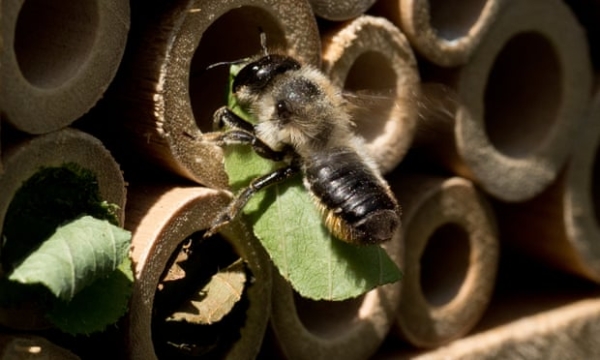National Pollinator Week Day 4 is all about Leafcutter Bees!
Yesterday we gave our attention and support to Mason and Blue Orchard Bees, two species of the Megachilidae family and both very important native pollinators of some of our favorite spring foods. Today, we are not straying too far from these busy little fruit pollinators as we dedicate our Thursday to the Leafcutter Bee.
The Leafcutter is also a member of the Megachilidae family (along with about 240 other North American species… big family!), which means that it too is a solitary bee and carries pollen in its belly or abdomen. And similarly to the Mason Bee, their name is a giveaway of how they make their nests. You guessed it, leaves.

These pollen-bellied insects also have their specific fruits and foods that they shine at when it comes to pollinating. These include blueberries, squash, peppers, carrots, and are superstars when it comes to pollinating a wide variety of wildflowers from all shapes and sizes.
Side note: One type of Leafcutter, called the Alfalfa Leafcutter Bee, or Megachile rotundata, is a helpful pollinator of alfalfa, however, this specific bee is not native, but in fact was brought to North America from Europe and Asia in the 1930s for commercial purposes.
Here are some similarities and differences of the Leafcutter Bee to its kin, the Mason and Blue Orchard:
- Similar to the Masons, Leafcutters nest in cavities or holes that are already created. This means you may be able to see some leafcutters residing in your Bee Hostel you just created!
- Just as the Masons, Leafcutters forage for pollen and nectar and create a ball of food with that and their own saliva, once again, meal prepping for their unborn egg.
- Leafcutters really do cut leaves and in almost perfectly round shapes too. They use these leaf bits to form a barricade at the front of their nest cavity (just as masons do with clay).
- You’ll find leafcutter bees like warmer weather than masons. Spot them in the summer months!
So it’s safe to say that a good way to support these little helpers is to plant for them, make a bee house or hostel and invite them in, and don’t get to upset with them when you see the tiny evidence of leaf snippings left behind!
More Sources:
Megachilidae by the Georgia Pollinator Partnership
Activities:
- Native Plant Checklist and Coloring Page: Go on a neighborhood search for some of these native plants and check them off as you go. Your neighbors may have them in their yards to spot, and you may even see some native pollinators near them! Come back home and color in the flowers and plants you saw.
- How’s your DIY Bee House going? Share with us your progress in the comments below!






